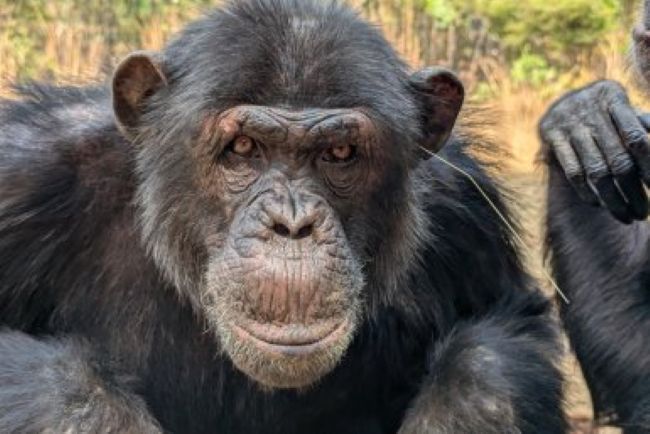 A new study observed chimpanzees putting grass in their ears and rears. Researchers are puzzling over this learned behavior. Image via Jake Brooker/ Chimfushi Wildlife Orphanage Trust/ Utrecht University.
A new study observed chimpanzees putting grass in their ears and rears. Researchers are puzzling over this learned behavior. Image via Jake Brooker/ Chimfushi Wildlife Orphanage Trust/ Utrecht University.
Chimpanzees wear blades of grass in their ears and rears
A team of researchers from Utrecht University in the Netherlands, Durham University in the U.K. and other institutions observed something remarkable at a chimpanzee sanctuary in Zambia. Several chimpanzees from one particular group were seen dangling blades of grass from their ear holes or their behinds, for no apparent reason. Researchers did not see the behavior in other chimpanzee groups at the same sanctuary, despite similar living conditions. Utrecht University researcher Edwin van Leeuwen said:
This shows that, like humans, other animals also copy seemingly pointless behaviors from one another. And that, in turn, may offer insights into the evolutionary roots of human culture.
People regularly do arbitrary things that seem to have no immediate use, like shaving a line into their eyebrow or putting a fashionable scarf on themselves or their dog. Most people do not come up with these things themselves, but copy them from others.
Other animals also adopt behaviors from one another. Often, though, this is useful behavior, like chimpanzees learning from each other how to find food. But sometimes, animals develop habits that seem to serve no clear purpose. For instance, a fashion trend among orcas, who observers saw wearing a dead salmon on their heads, drew quite a bit of media attention last year. Still, these kinds of “useless” trends in animals have rarely been studied in a systematic way.
Grass in ear
In 2010, van Leeuwen discovered that a female chimpanzee at the Chimfunshi Wildlife Orphanage Trust sanctuary repeatedly stuck a blade of grass in her ear and left it there, for no apparent reason. Later, seven of her group members adopted the behavior. And even after the female trendsetter died, the behavior continued, and some chimps in the group still do it today. Van Leeuwen and his colleagues therefore interpreted this behavior as a cultural tradition.
More than a decade later, chimpanzees in another group at the same sanctuary also began sticking blades of grass in their ears. They did not copy this behavior from the earlier group, since they had no contact with them. But in the new group, the grass-in-orifice trend did not stop there. While five of the eight chimpanzees in the new group stuck grass in their ears, six of the eight also let a blade of grass dangle from their behinds. The researchers found no evidence that the chimpanzees were bothered by their ear or behinds and used the blades of grass, for example, for relieving an itch.
Copied from caregivers
By carefully tracking which animals displayed the behavior over time, van Leeuwen and colleagues showed it was likely that the animals did not each invent the behavior on their own, but copied it from one another. When the researchers looked deeper into how the behavior started, they found something striking. Van Leeuwen said:
Both groups where chimps put blades of grass in their ears had the same caretakers. These caretakers reported that they sometimes put a blade of grass or a matchstick in their own ears to clean them. Caretakers in the other groups said they did not do this. The chimps in the one group then figured out to stick the blade of grass in another place as well.
 Environmental biologist Edwin van Leeuwen of Utrecht University in the Netherlands led the study of chimps’ use of blades of grass. It shows, he said, that “like humans, other animals also copy seemingly pointless behaviors from one another.” Image via Utrecht University.
Environmental biologist Edwin van Leeuwen of Utrecht University in the Netherlands led the study of chimps’ use of blades of grass. It shows, he said, that “like humans, other animals also copy seemingly pointless behaviors from one another.” Image via Utrecht University.
Free from natural selection
In the wild, researchers have not seen similar “useless” trends in chimpanzees. So why do they do it in captivity? Van Leeuwen explained:
In captivity, they have more free time than in the wild. They don’t have to stay as alert or spend as much time searching for food. Why they do exactly this particular thing, I’m not really concerned about. But them copying the behavior from each other, that is the important insight.
Human culture
The question of why humans are more culturally evolved than other animals is something scientists are still debating. Some scientists believe the key lies in humans’ unique ability to copy, including small, seemingly useless details. Other animals would not be able to do this and would have to constantly reinvent the wheel, which limits their cultural evolution. Co-author Jake Brooker of Durham University said:
But our study shows that chimpanzees are able to copy small, useless behaviors from each other. That is why we felt it was important to share these new observations.
Chimpanzees’ behavior not pointless after all?
Incidentally, van Leeuwen and colleagues are not entirely sure if the grass trend is truly useless. As van Leeuwen said:
It could also serve a social purpose. By copying someone else’s behavior, you show that you notice and maybe even like that individual. So, it might help strengthen social bonds and create a sense of belonging within the group, just like it does in humans.
Bottom line: Some chimpanzees in captivity imitated each other with the seemingly useless activity of putting a blade of grass in their ears and rears.
Source: Chimpanzees socially learn non-instrumental behaviour from conspecifics
Read more: Chimpanzees know how to party. Boozy fruit, anybody?
EarthSky Voices
View Articles
About the Author:
Members of the EarthSky community – including scientists, as well as science and nature writers from across the globe – weigh in on what’s important to them.